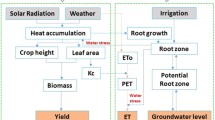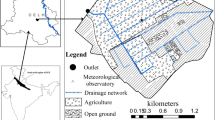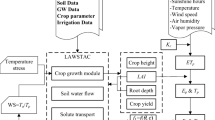Abstract
In Khorezm, a region located in the Aral Sea basin of Uzbekistan, water use for irrigation of predominantly cotton is high whereas water use efficiency is low. To quantify the seasonal water and salt balance, water application, crop growth, soil water, and groundwater dynamics were studied on a sandy, sandy loam and loamy cotton field in the years 2003 and 2005. To simulate and quantify improved management strategies and update irrigation standards, the soil water model Hydrus-1D was applied. Results showed that shallow groundwater contributed a substantial share (up to 399 mm) to actual evapotranspiration of cotton (estimated at 488–727 mm), which alleviated water stress in response to suboptimal quantities of water applied for irrigation, but enhanced concurrently secondary soil salinization. Thus, pre-season salt leaching becomes a necessity. Nevertheless, as long as farmers face high uncertainty in irrigation water supply, maintaining shallow groundwater tables can be considered as a safety-net against unreliable water delivery. Simulations showed that in 2003 around 200 mm would have been sufficient during pre-season leaching, whereas up to 300 mm of water was applied in reality amounting to an overuse of almost 33%. Using some of this water during the irrigation season would have alleviated season crop-water stress such as in June 2003. Management strategy analyses revealed that crop water uptake would only marginally benefit from a permanent crop residue layer, often recommended as part of conservation agriculture. Such a mulch layer, however, would substantially reduce soil evaporation, capillary rise of groundwater, and consequently secondary soil salinization. The simulations furthermore demonstrated that not relying on the contribution of shallow groundwater to satisfy crop water demand is possible by implementing timely and soil-specific irrigation scheduling. Water use would then not be higher than the current Uzbek irrigation standards. It is argued that if furrow irrigation is to be continued, pure sandy soils, which constitute <5% of the agricultural soils in Khorezm, are best to be taken out of annual cotton production.








Similar content being viewed by others
References
Abdullaev U (2003) Republic of Uzbekistan. Land degradation assessment in dry lands (LADA). State. Design and Research Institute (Uzgip), Tashkent
ADB (2008) Key Indicators for Asia and the Pacific 2008. Manila 2008, 252 pp. http://www.adb.org/Documents/Books/Key_Indicators/2008/pdf/Key-Indicators-2008.pdf. Last accessed in September 2008
Allen RG, Pereira LS, Raes D, Smith M (1998) Crop evapotranspiration—guidelines for computing crop water requirements—FAO Irrigation and drainage paper 56. Food and Agriculture Organization of the United Nations, Rome
Atashev D, Rachinsky AA, Horst GO (1966) Water management and ameliorative construction in the Khorezm region, FAN, Tashkent (in Russian)
Blake GR, Hartge KH (1986) Bulk density. In: Klute A (ed) Methods of soil analysis: Part 1 Physical and mineralogical methods, vol 2, pp 363–375. ASA and SSSA, Madison
Bos MG (1989) Discharge measurement structures. Kluwer, Dordrecht
Breckle S-W (2002) Walter’s vegetation of the Earth. The ecological systems of the geo-biosphere. Springer, Berlin, 300 p
Buttar GS, Aujla MS, Thind HS, Singh CJ, Saini KS (2007) Effect of timing of first and last irrigation on the yield and water use efficiency in cotton. Agric Water Manage 89:236–242
Conrad C (2006) Remote sensing based modeling and hydrological measurements for the assessment of agricultural water use in the Khorezm region (Uzbekistan). PhD thesis, University of Wuerzburg, 205 p (in German)
Coppi L (2004) Cotton crop in Khorezm region, Uzbekistan: bio-agronomical behavior under different pedological and hydrological conditions. MSc, University of Florence (in Italian)
Dhankar JS, Malik RS, Kairon MS (1980) Influence of preplanting irrigation and withholding of first irrigation on growth and yield of upland cotton. Indian J Agron 25:250–255
Djanibekov N (2008) A Micro-Economic Analysis of farm restructuring in the Khorezm Region, Uzbekistan. PhD thesis, University of Bonn. http://hss.ulb.uni-bonn.de/diss_online/landw_fak/2008/djanibekov_nodir/1435.pdf
Fabrizzi KP, Garcıa FO, Costa JL, Picone LI (2005) Soil water dynamics, physical properties and corn wheat responses to minimum and no-tillage systems in the southern Pampas of Argentina. Soil Tillage Res 81:57–69
FAO (1997) AQUASTAT, land and water development division. Uzbekistan. http://www.fao.org/nr/water/aquastat/countries/uzbekistan/index.stm. Last accessed in July 2008
FAOSTAT (2008) ProdSTAT module. http://faostat.fao.org/site/526/default.aspx. Last accessed in March 2009
FAO and WFP (2000) Special report: FAO/WFP Crop and Food Supply Assessment Mission to the Karakalpakstan and Khorezm Regions of Uzbekistan. FAO/WFP, Rome, 17 pp. http://www.fao.org/docrep/004/x9188e/x9188e00.htm. Last accessed in July 2008
Feddes RA, Kowalik PJ, Zaradny H (1978) Simulation of field water use and crop yield. Simulation monographs. Pudoc, Wageningen, pp 1–189
Felitsiant IP (1964) Soil of Khorezm region. Sbornik “Pochvi Uzbekskoy SSR”. AN UzSSR, Tashkent (in Russian)
Grimes DW, Dickens WL, Yarnada N (1978) Early-season water management for cotton. Agron J 70:1009–1012
Hanson BR, Peters D (2000) Soil type affects accuracy of dielectric moisture sensors. Calif Agric 54:43–47
Hoffman GJ, Hall C (1996) Leaching fraction and root zone salinity control. In: Tanji KK (ed) Agricultural salinity assessment and management. ASCE manuals and reports on engineering practice No. 71. American Society of Civil Engineers, New York, pp 237–261
Howell TA, Evett SR, Tolk JA, Schneider AD (2004) Evapotranspiration of full-, deficit-irrigated, and dryland cotton on the Northern Texas High Plains. J Irrig Drainage Eng (ASCE) 130:277–285
Ibragimov N, Evett SR, Esanbekov Y, Mirzaev L, Lamers JPA, Kamilov BS (2007) Water use efficiency of irrigated cotton in Uzbekistan under drip and furrow. Agric Water Manage 90:112–120
Ibrakhimov M (2004) Spatial and temporal dynamics of groundwater table and salinity in Khorezm (Aral Sea Basin), Uzbekistan. Ecology and Development Series 24. Cuvillier Verlag, Göttingen
Jabbarov HM, Usmanov AU, Yusupov AR, Yakubov HE (1977) To establish the regularity of changes in soil during leaching and irrigation of crops with saline water and to develop the mathematical model for salt movement calculation, pp 1–148. SANIIRI (in Russian)
Kamilov B, Ibragimov N, Esanbekov Y, Evett SR, Heng LK (2003) Drip irrigated cotton: irrigation scheduling study by use of soil moisture neutron probe. Int Water Irrig 1:38–41
Khamzina A, Lamers JPA, Vlek PLG (2008) Tree establishment under deficit irrigation on degraded agricultural land in the lower Amu Darya River region, Aral Sea Basin. For Ecol Manag 255:168–178. doi:10.1016/j.foreco.2007.09.005
Kienzler K (2009) Improving N use efficiency and crop quality in the Khorezm region, Uzbekistan, 230 p. PhD thesis, Rheinische Friedrich-Wilhelms-Universität Bonn
Kurambaev M (1969) Irrigation regime of cotton on the saline soils of Khorezm region (In Russian), p 213. SoyuzNIXI
Lamers JPA, Khamzina A (2008) Fuelwood production in the degraded agricultural areas of the Aral Sea Basin, Uzbekistan. Bois et Forets des Tropiques 297:47–57
Loveland PJ, Whalley WR (2001) Particle size analysis. In: Smidth KA, Mullins CE (eds) Soil and environmental analysis: physical methods (revised and expanded), vol 2, pp 281–315. Marcel Deccer Inc., New York
Müller M (2006) A general equilibrium approach to modelling water and land use reforms in Uzbekistan. PhD thesis, Rheinische Friedrich-Wilhelms-Universität Bonn
Schaap MG, Leij FJ, van Genuchten MT (2001) Rosetta: A computer program for estimating soil hydraulic parameters with hierarchical pedotransfer functions. J Hydrol 251:163–176
Šimunek J, van Genuchten MT, Šejna M (2005) The HYDRUS-1D software package for simulating the one-dimensional movement of water, heat, and multiple solutes in variably-saturated media. Version 3.0, HYDRUS Software Series 1, Department of Environmental Sciences, University of California Riverside, Riverside, CA, 270 pp
Šimunek J, van Genuchten MT, Šejna M (2008) Development and applications of the HYDRUS and STANMOD software packages, and related codes. Vadose Zone J 7:587–600
Sommer R, Wall PC, Govaerts B (2007) Model-based assessment of maize cropping under conventional and conservation agriculture in highland Mexico. Soil Tillage Res 94:83–100
Sommer R, Kienzler K, Conrad C, Ibragimov N, Lamers J, Martius C, Vlek PLG (2008) Evaluation of CropSyst for simulating the potential yield of cotton in Uzbekistan. Agron Sustain Dev. doi:10.1051/agro:2008008
Soyusnihi (1992) Methodology for hydro-module zoning. Fan Publisher, Tashkent (in Russian)
Steiner JL (1989) Tillage and surface residue effects on evaporation from soils. Soil Sci Soc Am J 53:911–916
Steiner JL (1994) Crop residue effects on water conservation. In: Unger PW (ed) Managing agricultural residues. Lewis Publ, Boca Raton, pp 41–76
Stockton JR, Doneen LD, Walhood VT (1961) Boll shedding and growth of cotton plant in relation to irrigation frequency. Agron J 53:272–275
Taylor SA, Ashcroft GM (1972) Physical edaphology. Freeman and Co., San Francisco, pp 434–435
Unger PW (1986) Wheat residue management effects on soil water storage and corn production. Soil Sci Soc Am J 50:764–770
USBR (1997) Water measurement manual, vol 3, pp 1–317. US Department of the Interior Bureau of Reclamation, Washington
USDA (2008) Cotton: world markets and trade. USDA, FAS Circular Series FOP 08-05, May 2008. http://usda.mannlib.cornell.edu/usda/current/cotton-market/cotton-market-05-01-2008.pdf. Last accessed in July 2008
Van Genuchten MT (1980) A closed-form equation for predicting the hydraulic conductivity of unsaturated soils. Soil Sci Soc Am J 44:892–898
Van Genuchten MT (1987) A numerical model for water and solute movement in and below the root zone. Research Report 121. USDA-ARS, US Salinity Laboratory, Riverside
Vogel T, Císlerová M (1988) On the reliability of unsaturated hydraulic conductivity calculated from the moisture retention curve. Trans Porous Media 3:1–15
Wanjura DF, Mahan JR, Upchurch DR (1996) Irrigation starting time effects on cotton under high-frequency irrigation. Agron J 88:561–566
Wehrheim P, Martius C (2008) Farmers, cotton, water and models: introduction and overview. In: Wehrheim P, Schoeller-Schletter A, Martius C (eds) Continuity and change. Land and water use reforms in rural Uzbekistan—socio-economic and legal analyses for the region Khorezm. Leibniz Institute of Agricultural Development in Central and Eastern Europe (IAMO). Studies on the Agricultural and Food Sector in Central and Eastern Europe, vol 43, pp 1–16. http://www.iamo.de/dok/sr_vol43.pdf
Acknowledgments
This study was funded by the German Ministry for Education and Research (BMBF; project number 0339970A). Special thanks are due to Prof. Jirka Šimunek for his valuable support and discussion on the Hydrus-1D simulations.
Author information
Authors and Affiliations
Corresponding author
Additional information
Communicated by J. Ayars.
Rights and permissions
About this article
Cite this article
Forkutsa, I., Sommer, R., Shirokova, Y.I. et al. Modeling irrigated cotton with shallow groundwater in the Aral Sea Basin of Uzbekistan: I. Water dynamics. Irrig Sci 27, 331–346 (2009). https://doi.org/10.1007/s00271-009-0148-1
Received:
Accepted:
Published:
Issue Date:
DOI: https://doi.org/10.1007/s00271-009-0148-1




